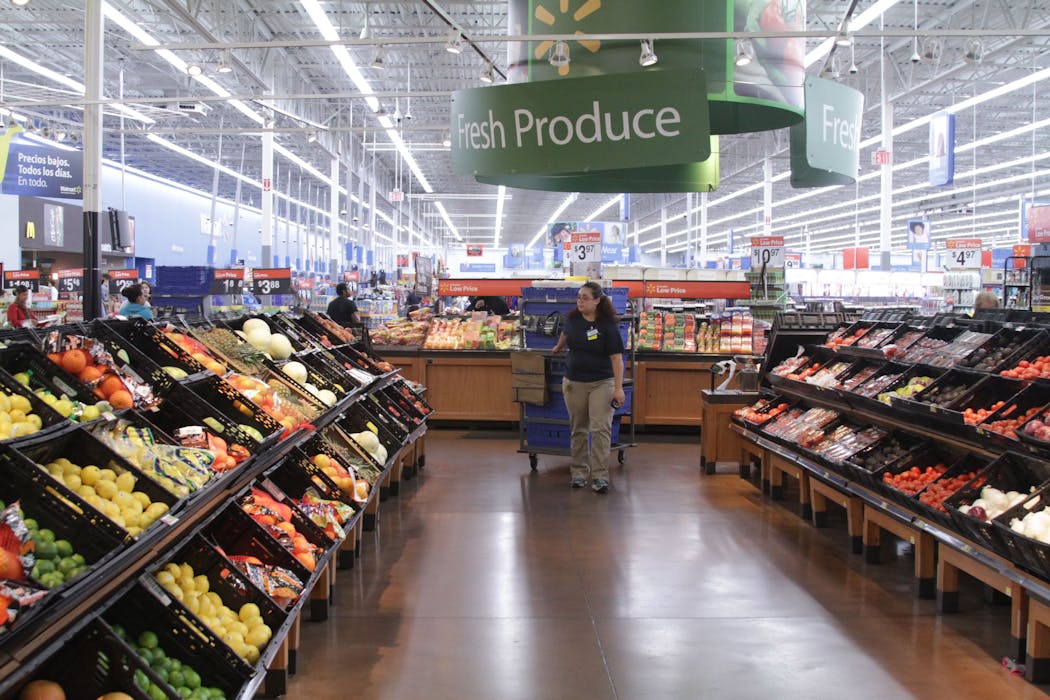Harriet Litel became more serious about her grocery budget after retiring from her banking job in 2016.
She regularly drives to the Walmart in Eden Prairie, bypassing markets closer to her Hopkins home, and believes she saves as much as 25% on groceries.
"The stuff I buy here is cheaper than I could find anywhere else," said Litel, 75, as she put groceries into her car one recent afternoon.
Following a pandemic boom for grocers, inflation is driving shoppers from across the economic spectrum to Bentonville, Ark.-based Walmart, even in the Twin Cities area's already competitive grocery market.
"The luxury customer, the aspirational customer, they're not shopping at Whole Foods anymore," said Liza Amlani, a retail merchandising expert and founder of the Retail Strategy Group. "They're shopping at Walmart."
Top of Twin Cities
There are different measures for market share, but in two popular rankings, Walmart and Cub vie for first and second place.
Walmart is in the No. 1 spot for market share in the Twin Cities area, according to Chain Store Guide. Rounding out the top five are Target, Cub, Costco and, in fifth place, Lunds & Byerlys. Counting franchised Cub locations as well, though, puts Cub and Target in a tie for second.
In a Metro Market Share ranking, Cub comes in first with Walmart, Target, Costco and Jerry's Foods following. Providence, R.I.-based United Natural Foods Inc., owns Cub after acquiring its former parent company, Eden Prairie-based Supervalu, in 2018. Jerry's owns and operates several stores under its Jerry's Foods banner as well as some franchised Cub stores in the metro area.
Other grocers making either Top 10 list for the metro: Aldi, Hy-Vee, Sam's Club, Trader Joe's and Whole Foods.
Nationwide, Kroger, which isn't present in the Twin Cities, and Costco are the second- and third-largest grocers nationally behind Walmart.
To cope with inflation, shoppers are moving to stores such as Walmart and Cub that offer large assortments and promote their competitive prices.
"There's a lot more choice within the produce mix at Walmart than there is at Target." Amlani said.
The number of high-income Walmart shoppers has grown dramatically, with 28% of U.S. households with annual income of at least $150,000 being members of the Amazon Prime-like Walmart+. That's up from 13% a year ago, said Scott Moses — Solomon Partners managing director heading grocery, pharmacy and restaurants — via email.
Target is feeling the impact. The retailer this month reported its comparable sales dipped in May, June and July, the first time sales from stores open for the past year dropped for the Minneapolis chain since spring 2017. At Walmart, comparable sales grew 6.4% in the same quarter thanks to grocery and health and wellness while general merchandise sales declined modestly.
"Target is still struggling with a lot of stores that have the food department in the back of the store versus in the front of the store," said Phil Lempert, editor of Supermarketguru.com.
Target is looking at different ways to improve grocery sightlines and to tell its value story, including how the majority of its privately branded Good and Gather items are under $5, said Rick Gomez, Target's head of food and beverage. The retailer continues to see growth in same-day services, such as pickup.
"The size of food and beverage depends on the size of the store and the location of the store, but we're always trying to meet the needs of the community near that store," Gomez said.
Grocers such as Costco cater to bulk-buying shoppers who seek value without sacrificing taste.
"You look at somebody like Costco, which has done a phenomenal job with the quality of their meat department," Lempert said. "People look at Costco and think value plus quality."
Amlani sees opportunity for small stores and co-ops to compete by doubling down on delivering exactly what their shoppers want.
To focus on that customer experience, Seward Community Co-op's Franklin Avenue store is undergoing a renovation with bulk products moving up front.
"For us, the bulk section, it's one of the reasons people shop at a co-op," spokesperson Natalia Mendez said.
Customer needs
Upscale Lunds & Byerly's managed to stay in the top five in the Chain Store Guide ranking, which Amlani attributed to the Edina-based chain knowing how to connect with customers who favor shopping local, organic produce and sustainable seafood.
Grocery executives see shoppers going to multiple stores to fill their fridge and pantry, a shift in the past 25 years from customers primarily visiting one or two stores.
Given that backdrop, Tres Lund, president of Lund Food Holdings Inc., sees a solid place for his upmarket family-run grocer. The company updates existing Lunds & Byerlys stores and offerings regularly, adding new items such as Easy Eats ready-to-heat entrees and sides. A culinary team is behind 5,000 private-label products.
"We're not competing with someone else's format," Lund said. "We're competing with keeping our customer loyalty and to continue to improve what we're doing for our customer base."
Lunds & Byerly's is in its 12th year of market-share growth, from nearly 7% in 2010 to more than 11% in Nielsen's data currently, Lund said.
He expects the chain of 28 stores, which says it is "committed to providing every customer with a sensational shopping experience," to continue adding locations in the third- and fourth-tier suburbs, with an Apple Valley store opening Sept. 14.
At the other end of the spectrum, Aldi holds a relatively small share of the Twin Cities grocery market but is in expansion mode and plans to add 120 new stores nationwide this year to reach a total of more than 2,400 stores by year-end.
Retail observers find the affordable chain increasingly popular with younger shoppers.
Bethany Bickel, who stopped at the Eden Prairie Walmart recently for sweet breads she couldn't find at Aldi, is one of them.
"I like the simplicity of Aldi, and they have a good assortment of organic produce, which is important to me," the Hopkins 22-year-old said.
Bickel used to shop at Lakewinds Food Co-op and Fresh Thyme, but when that "wasn't realistic anymore," she switched to Aldi and Costco this spring to save money.
Pulling back
As grocery competition evolves, some chains are scaling back. West Des Moines, Iowa-based Hy-Vee, which opened its first metro store in 2015, announced last year it would sell five land parcels in Farmington, Chaska, Blaine, West St. Paul and Maple Grove rather than build stores there.
Amazon had opened a few dozen Amazon Fresh grocery stores nationwide before the company decided to pause its expansion early this year as it reconsidered the store's differentiation from competitors.
In the Twin Cities, there were at least six locations — Arden Hills, Coon Rapids, Burnsville, Eagan, Eden Prairie and Lakeville — built to have a similar Amazon Fresh façade, including a distinct green stripe over the doors. The city of Burnsville received a sign permit for Amazon Fresh that it approved, but Amazon hasn't confirmed the locations. According to a Mid-America Real Estate broker, the six empty retail spaces are up for sublease.
Retail observers are split on whether Amazon will disrupt the grocery industry.
"What may be most fascinating for retail observers, is that by [Amazon CEO Andy] Jassy's own admission, Amazon has not yet figured out grocery," said Moses, of Solomon Partners. "Given Amazon's unmatched financial resources and fairly clear commitment to grocery as part of its ubiquitous retail leadership strategy, one daunting question unquestionably pervading American grocery boardrooms is, 'What happens when they do?'"
Star Tribune staff writer Nicole Norfleet contributed to this story.

Bushel Boy, Minnesota's local tomato grower, sold
After 60 years, federal cuts shutting down Job Corps center in St. Paul

In a first, Minnesota doctors walk their own picket line, then hustle to see patients
It's harder to find a job this year, especially a corporate position




